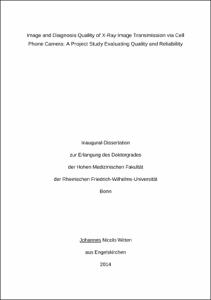Image and Diagnosis Quality of X-Ray Image Transmission via Cell Phone CameraA Project Study Evaluating Quality and Reliability

Image and Diagnosis Quality of X-Ray Image Transmission via Cell Phone Camera
A Project Study Evaluating Quality and Reliability

| dc.contributor.advisor | Burger, Christof | |
| dc.contributor.author | Witten, Johannes Nicolo | |
| dc.date.accessioned | 2020-04-19T11:15:13Z | |
| dc.date.available | 2020-04-19T11:15:13Z | |
| dc.date.issued | 07.05.2014 | |
| dc.identifier.uri | https://hdl.handle.net/20.500.11811/5887 | |
| dc.description.abstract | Introduction: Developments in telemedicine have not produced any relevant benefits for orthopedics and trauma surgery to date. For the present project study, several parameters were examined during assessment of x-ray images, which had been photographed and transmitted via cell phone. Materials and Methods: A total of 100 x-ray images of various body regions were photographed with a Nokia cell phone and transmitted via email or MMS. Next, the transmitted photographs were reviewed on a laptop computer by five medical specialists and assessed regarding quality and diagnosis. Results: Due to their poor quality, the transmitted MMS images could not be evaluated and this path of transmission was therefore excluded. Mean size of transmitted x-ray email images was 394kB (range:265- 59OkB,SD ± 59), average transmission time was 3.29 min ± 8 (CI 95%: 1.7-4.9). Applying a score from 1- 10 (very poor - excellent) mean image quality was 5.8. In 83.2 ± 4% (mean value ± SD) of cases (median 82; 80-89%), there was agreement between final diagnosis and assessment by the five medical experts who had received the images. However, there was a markedly low concurrence ratio in the thoracic area and in pediatric injuries. Discussion: While the rate of accurate diagnosis and indication for surgery was high with a concurrence ratio of 83%, considerable differences existed between the assessed regions, with lowest values for thoracic images. Teleradiology is a cost-effective, rapid method which can be applied wherever wireless cell phone reception is available. In our opinion, this method is in principle suitable for clinical use, enabling the physician on duty to agree on appropriate measures with colleagues located elsewhere via x-ray image transmission on a cell phone. | en |
| dc.language.iso | deu | |
| dc.language.iso | eng | |
| dc.rights | In Copyright | |
| dc.rights.uri | http://rightsstatements.org/vocab/InC/1.0/ | |
| dc.subject.ddc | 610 Medizin, Gesundheit | |
| dc.title | Image and Diagnosis Quality of X-Ray Image Transmission via Cell Phone Camera | |
| dc.title.alternative | A Project Study Evaluating Quality and Reliability | |
| dc.type | Dissertation oder Habilitation | |
| dc.publisher.name | Universitäts- und Landesbibliothek Bonn | |
| dc.publisher.location | Bonn | |
| dc.rights.accessRights | openAccess | |
| dc.identifier.urn | https://nbn-resolving.org/urn:nbn:de:hbz:5n-35994 | |
| dc.relation.doi | https://doi.org/10.1371/journal.pone.0043402.s001 | |
| ulbbn.pubtype | Zweitveröffentlichung | |
| ulbbnediss.affiliation.name | Rheinische Friedrich-Wilhelms-Universität Bonn | |
| ulbbnediss.affiliation.location | Bonn | |
| ulbbnediss.thesis.level | Dissertation | |
| ulbbnediss.dissID | 3599 | |
| ulbbnediss.date.accepted | 23.04.2014 | |
| ulbbnediss.institute | Medizinische Fakultät / Kliniken : Klinik und Poliklinik für Orthopädie und Unfallchirurgie | |
| ulbbnediss.fakultaet | Medizinische Fakultät | |
| dc.contributor.coReferee | Vatter, Hartmut |
Files in this item
This item appears in the following Collection(s)
-
E-Dissertationen (1939)




